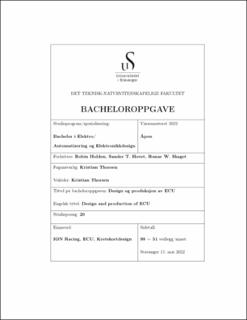| dc.contributor.advisor | Thorsen, Kristian | |
| dc.contributor.author | Hovet, Sander T. | |
| dc.contributor.author | Skaget, Runar W. | |
| dc.contributor.author | Holden, Robin | |
| dc.date.accessioned | 2022-07-12T15:51:33Z | |
| dc.date.available | 2022-07-12T15:51:33Z | |
| dc.date.issued | 2022 | |
| dc.identifier | no.uis:inspera:93568960:50807747 | |
| dc.identifier.uri | https://hdl.handle.net/11250/3004732 | |
| dc.description.abstract | Prosjektet har vært et utviklingsprosjekt, der det har blitt designet og pro-
dusert en Electronic Control Unit (ECU) for ION Racing. ION Racing er en
studentdrevet organisasjon som bygger elektriske racebiler. Vår ECU skal
implementeres i 2023 bilen.
ECU-en består av tre kretskort. Et styrekort, et sensorkort og et tempera-
turkort. Styrekortet styrer motoren ved å lese data fra gasspedalsensoren
(APPS) og sender verdiene til motorkontrolleren (MCU) over CAN. Styre-
kortet styrer også blant annet bremselys, dashbordlys, og Ready to Drive
Sound (RTDS). Sensorkortet leser inn data fra hjulrotasjonsensorer (RPMS)
og dempingsensorer (WSS), og sender sensordataen ut på CAN. Tempe-
raturkortet overvåker temperaturen i kjølesystemet og motorkontrolleren
ved å lese inn temperaturen fra Air Coolant Temperature Sensor (ACTS)
og Fluid Coolant Temperature Sensor (FCTS). Temperaturkortet styrer en
pumpe for å pumpe vannet i kjølesystemet, og en vifte for å regulerer tem-
peraturen på radiatoren. Kretskortene kommuniserer med hverandre over
CAN, og har hver sin mikrokontroller for å prosessere sensordata og styre
utganger.
Det har i tillegg blitt utviklet programvare til ECU-en og et testkort for
å teste om systemet virker. Programvaren omfatter innlesning av sensorer
og styring av utganger, samt oppsett av CAN-kommunikasjon. Det er også
blitt designet og produsert et testkort. Testkortet inneholder potensiometre
for å simulere sensorer på racebilen, samt brytere og lys for å simulere
dashbordet.
Designfasen har bestått i å planlegge hvordan ECU-en skal konstrueres.
Dette omfatter hvordan ECU-en skal inndeles, hvilke sensorer og utganger
som skal styres, samt hvordan sensorsignalene skal behandles. Neste del av
designfasen har bestått i å finne komponenter og tegne skjemategning, samt
kretskortutlegg. Produksjonsfasen har bestått i å få kretskortene produsert
i Kina samt pålodding av komponenter. Siste fase i prosjektet omfattet
testing og utvikling av programvare.
Prosjektet har vært et komplekst utviklingsprosjekt som har gått ifra en idé
til et ferdig produkt. | |
| dc.description.abstract | The project has been a R&D project, where it has been designed and manufactured an Electronic Control Unit (ECU) for ION Racing. ION Racing is a student organization which makes an electronic race car. Our ECU will be implemented in the 2023 car.
The ECU is devided into three PCBs. A control module, a sensor module, and a temperature module. The control module controls the motor by reading data from the acceleration pedal and sending these values to the motor controller (MCU) over CAN-bus. The control module also controls the brakelight, dashboard LEDs and "Ready to Drive Sound (RTDS)". The sensor module reads data from RPM sensors and wheel suspension sensors, and sends these values over the same CAN-bus. The temperature module observes the temperature in the motor and the cooling system by reading the "Air Coolent Temperature Sensor" and the "Fluid Coolant Temperature Sensor". The temperature module controls a cooling pump by pumping water in the cooling system, and controls a cooling fan to regulate the temperature in the radiator. The PCBs communicate with each other by CAN-bus and they each have their own microcontroller to prosess data and control outputs.
It has been developed software for the ECU and a test board to test the system. The software reads sensordata and control outputs as well as setting up the CAN-bus. It has also been designed a test board. The testboard contains potentiometers to simulate analog sensors on the car, as well as buttons and LEDs to simulate the dashboard.
The design phase included planning how the ECU should get manufactured. This involves how the ECU should be split up into modules, which sensors and outputs will be controlled, as well as how the data from the sensors should be processed. The next phase included finding components and drawing schematics and PCB design. The production phase included producing the PCBs in China and solder components. The last phase included testing and software development.
The project has been a complex R&D project, which evolved from an idea to a product. | |
| dc.language | nob | |
| dc.publisher | uis | |
| dc.title | Design og produksjon av ECU | |
| dc.type | Bachelor thesis | |
